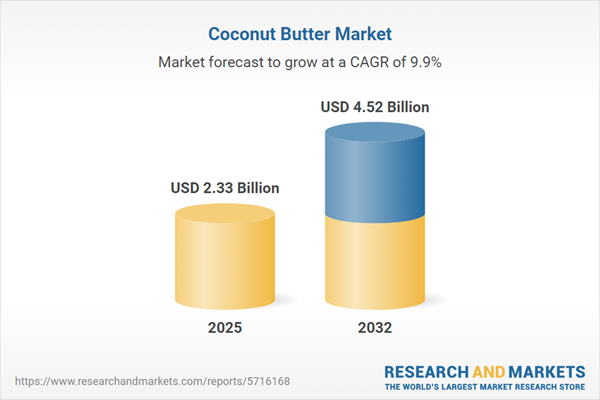Speak directly to the analyst to clarify any post sales queries you may have.
Senior executives in the coconut butter industry face a fast-changing landscape, shaped by evolving consumer values, increased health focus, and shifting supply chain models. As market demands become more nuanced, decision-makers must continuously align operational strategies with innovation and regional differences for sustained growth and resilience.
Market Snapshot: Global Coconut Butter Market Size and Growth
The global coconut butter market achieved a value of USD 2.12 billion in 2024, with growth spanning diverse regions and use cases. Driven by a shift towards natural and plant-based diets, manufacturers and distributors are rethinking core strategies to address both B2B and direct-to-consumer channels. The adoption of digital procurement methods and technological innovation is becoming central to optimizing go-to-market approaches. Leading companies are focusing on expanding omni-channel distribution and fine-tuning supply chains to gain competitive advantages as product offerings diversify and respond to regional preferences across mature and emerging markets.
Coconut Butter Market Scope & Segmentation
- Distribution Channels: The B2B coconut butter landscape is supported by supermarkets, specialty stores, convenience outlets, and e-commerce platforms. These channels facilitate wholesale procurement and ongoing supply partnerships that underpin market stability and growth.
- Product Types: Market offerings range from refined to unrefined coconut butter, emphasizing clean-label and value-added blends that meet culinary, nutritional, and wellness requirements across segments.
- End Users: Foodservice operators demand specialized packaging solutions, while retail-oriented developments drive differentiation in consumer-facing venues, enhancing shelf appeal and brand recognition.
- Packaging Sizes: Flexible packaging formats—including small retail containers and scalable bulk options—enable efficient fulfillment for manufacturers and distributors serving varied procurement needs.
- Flavors: Product innovation includes coconut butter infused with cocoa, turmeric, and matcha, directly addressing the growing need for variety and functional benefits within the health-conscious consumer base.
- Certification Types: Both organic and conventional certification choices are present, aligning with global sourcing criteria and procurement standards while supporting sustainability and compliance goals.
- Key Regions: Regional markets in the Americas, Europe, Asia-Pacific, the Middle East, and Africa each bring distinct consumer expectations and regulatory considerations, requiring customized marketing and operational strategies for successful entry and sustained growth.
- Notable Companies: Key market participants—such as Nutiva Inc., Artisana Organics, Tropical Traditions LLC, Sunfood Superfoods, and Danone S.A.—are solidifying their market roles through advanced logistics investments and regional programs tailored to local consumer needs.
Coconut Butter Market: Key Takeaways for B2B Decision-Makers
- Strengthening supply chain capabilities is essential to ensure reliable order fulfillment and adapt to evolving marketplace conditions.
- Expanding flavor profiles and developing functional product blends broaden customer reach and help differentiate brands in competitive sectors.
- Embracing digital procurement and ethical sourcing practices supports more transparent and resilient supply chains for plant-based product demands.
- Pursuing collaborative strategies with suppliers, producers, and packaging partners enhances organizational agility and supports rapid responses to customer and regulatory demands.
- Integrating data analytics into sales and marketing enables a more targeted approach, helping to adjust product offerings and messaging in line with region-specific behaviors and market trends.
- Investing in geographic expansion builds adaptive networks and supports continuity and resilience, benefiting both market entrants and established brands.
Tariff Impact: US Tariff Adjustments 2025
- Reviewing sourcing strategies and utilizing flexible contract terms can help businesses manage procurement risks related to shifting tariff regulations impacting the coconut butter sector.
- Building closer relationships with domestic suppliers can reduce exposure to supply disruptions and provide greater operational consistency during regulatory transitions.
- Implementing digital documentation streamlines compliance, supports automated processing for customs, and allows for quicker adaptation to changing trade requirements.
- Adjusting trade practices to prioritize compliance opens opportunities for development of value-added and plant-based coconut butter products suited to specific market segments.
Methodology & Data Sources
This analysis draws on comprehensive secondary research, direct consultation with key industry figures, and proprietary analytics. All insights are validated by subject matter experts to maintain accuracy and support data-driven decision-making for market stakeholders.
Why This Report Matters
- Empowers executive teams to anticipate competitive strategies and optimize operational responses within the dynamic coconut butter segment.
- Provides clear recommendations for navigating compliance, increasing productivity, and gaining access to emerging markets despite evolving regulations.
- Facilitates swift identification of growth opportunities, helps minimize supply chain risk, and supports optimal resource allocation for sustained business performance.
Conclusion
Robust, up-to-date market intelligence allows senior leaders to enhance organizational capabilities, respond to market volatility, and capitalize on strategic opportunities in the coconut butter market.
Additional Product Information:
- Purchase of this report includes 1 year online access with quarterly updates.
- This report can be updated on request. Please contact our Customer Experience team using the Ask a Question widget on our website.
Table of Contents
3. Executive Summary
4. Market Overview
7. Cumulative Impact of Artificial Intelligence 2025
Companies Mentioned
The companies profiled in this Coconut Butter market report include:- Nutiva Inc.
- Artisana Organics, Inc.
- Let's Do Organic LLC
- Tropical Traditions LLC
- Sunfood Superfoods (Sunfood, LLC)
- Veva Group LP
- Dr. Bronner’s, LLC
- United Natural Foods, Inc.
- Conagra Brands, Inc.
- Danone S.A.
Table Information
| Report Attribute | Details |
|---|---|
| No. of Pages | 189 |
| Published | October 2025 |
| Forecast Period | 2025 - 2032 |
| Estimated Market Value ( USD | $ 2.33 Billion |
| Forecasted Market Value ( USD | $ 4.52 Billion |
| Compound Annual Growth Rate | 9.9% |
| Regions Covered | Global |
| No. of Companies Mentioned | 11 |









